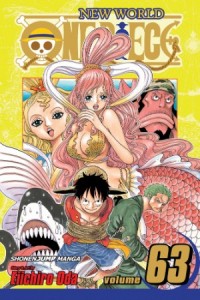By Eiichiro Oda. Released in Japan by Shueisha, serialization ongoing in the magazine Weekly Shonen Jump. Released in North America by Viz.
There’s always a risk that Oda runs because he puts everything into his manga. This is not a title like Bleach, where a 5-minute fight can take three months of real time. There’s always at least ten different things going on. The difficulty is in trying to keep all that happening and not confuse or alienate the audience with too much information all at once. And in this volume, I’m afraid a lot of the time Oda doesn’t quite manage it. He’s simply trying to do too much too fast here, using too many characters that we haven’t grown to care about yet.
This is basically a volume in two halves. The first continues the melee battle on Fishman Island, as the Straw Hats get in between a civil war/coup started by Hody Jones and his brand of outlaw scum. Of course, they’re powerful outlaw scum, so King Neptune and his good guys are getting pounded. Meanwhile, Luffy has succeeded in getting Princess Shiratori outside, but this quickly leads to even more chaos. And then there’s Jimbei, who is down by the grave of the princess’ mother, feeling guilt and sadness. There are some nifty fights (Zoro is, as usual, badass) and the odd goofy comedic moment (Sanji seems to finally get better here, after briefly turning to stone (which I’m sure isn’t meant to be metaphorical at ALL.) But mostly the chaos is what’s driving everything, and this does make things incoherent at times.
Some things to note: Nami’s subplot is actually quite interesting. She’s recognized, sort of, as being an ex-member of Arlong’s crew, and certainly Jimbei’s guilt is directed quite a bit in her direction. But we don’t really see her reacting much beyond faraway looks and the occasional sweatdrop. I like to think that it’s Oda showing that Nami is finally starting to move on from her past (we get a nice page-long flashback from Nami for those readers who may have forgotten it), but also we see that she can also see things from the other side now, and is more aware of the prejudice and persecution that fish-people have suffered. Not that she’s forgiving Arlong anytime soon.
Which leads us into the big flashback. This is an unusual flashback in that it doesn’t seemingly stem from a crewmember’s past and end with them joining Luffy – unless that’s meant to be Jimbei. Instead, we meet Fisher Tiger and Queen Otohime, two characters whose dreams and ideals for their people are contrasted against each other. Fisher Tiger knows what’s right and tries to follow that, but the constant abuse of humanity against his people has ground him down. As for Queen Otohime, her naivete is contrasted with her nobility and pure stubbornness, and we learn that even if fishmen and humanity can try to move closer together, it only seems to take one person with different ideas to screw everything up. As you might guess, prejudice is not an easy fix, especially when it involves slavery.
The aftermath of the queen’s death will have to wait for the next volume, as she dies on the last page (Oda even notes there’s no room for extras this time). But it’s not going to be pretty. Oda is showing us that the world is a complex, contrasting, and sometimes horrible place. Even if he’s trying to jam it into a narrative already overstuffed with political battles and revolutions. Next volume should have a lot of fights, which will actually come as a relief after all this buildup, I think.
(Also, Oda’s response to the reader asking who the father of Makino’s child is is classic Odatroll. He clearly knows all about the Shanks/Makino shippers, and is baiting them mercilessly.)



